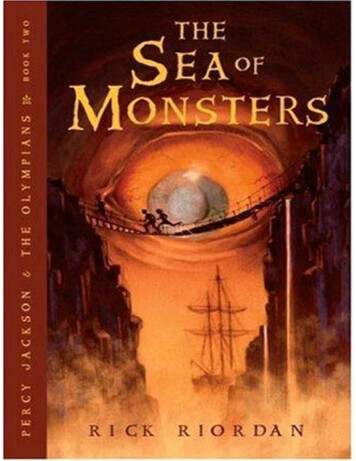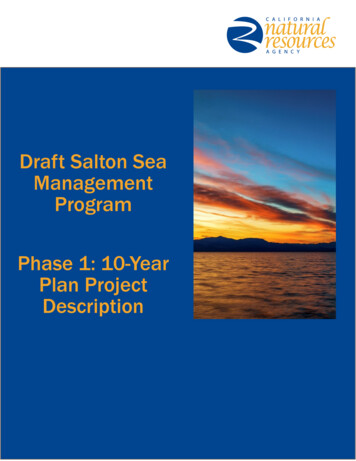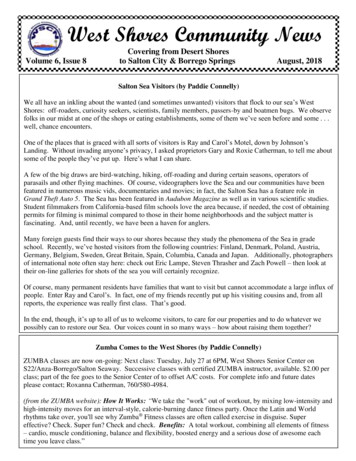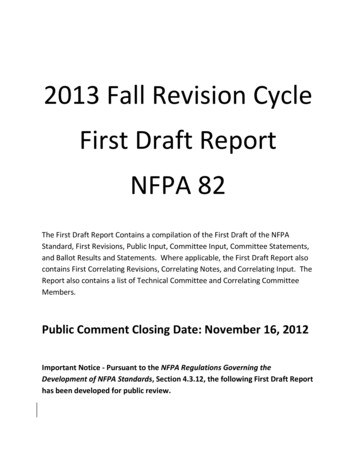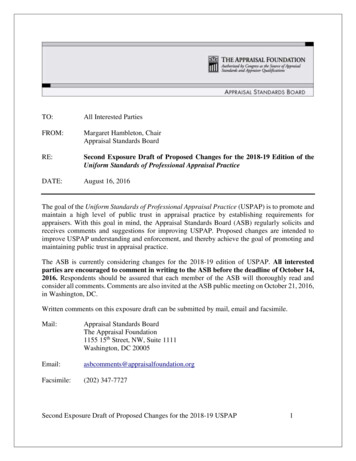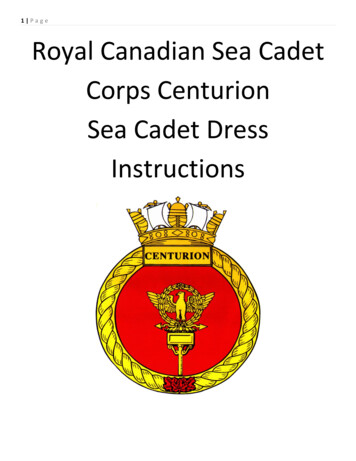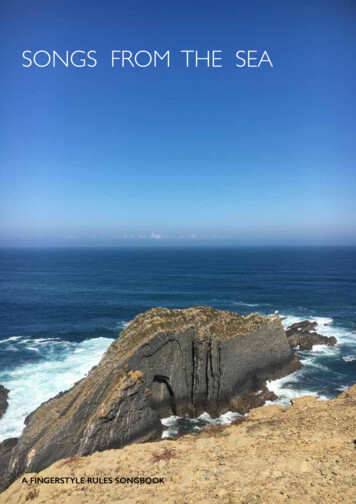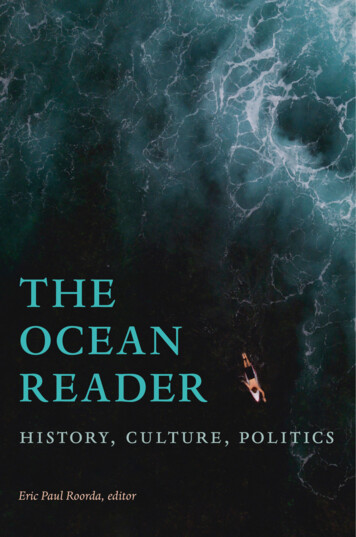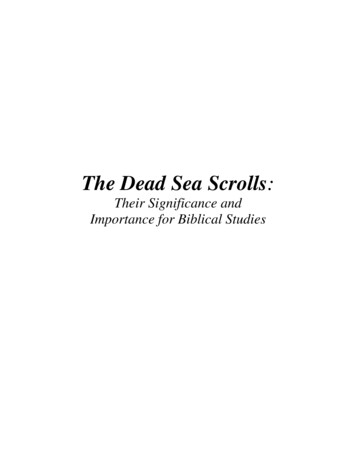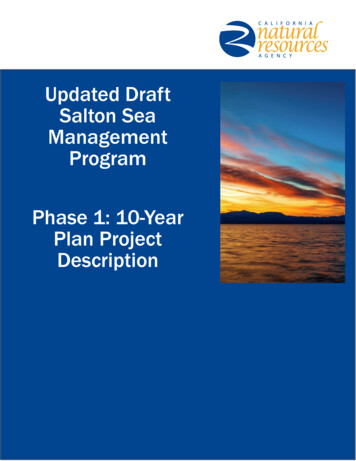
Transcription
Updated DraftSalton SeaManagementProgramPhase 1: 10-YearPlan ProjectDescription
This Page Intentionally Left Blank
Updated Draft Salton Sea Management ProgramPhase 1: 10-Year Plan Project DescriptionDocument InformationPrepared forCalifornia Natural Resources AgencyProject NameSalton Sea Management Program Phase 1: 10-Year Plan ProjectDescriptionProject Number3267600100Project ManagerTamara KlugDateMarch 2021Prepared for:California Natural Resources Agency1416 Ninth Street, Suite 1311Sacramento, California 95814Prepared by:Cardno, Inc.201 N. Calle Cesar Chavez, Suite 203Santa Barbara, California 93103March 2021Draft Salton Sea Management Program Phase I: 10-Year PlanDocument Information i
Updated Draft Salton Sea Management ProgramPhase 1: 10-Year Plan Project DescriptionThis Page Intentionally Left BlankMarch 2021Draft Salton Sea Management Program Phase I: 10-Year PlanDocument Information ii
Updated Draft Salton Sea Management ProgramPhase 1: 10-Year Plan Project DescriptionTable of ContentsIntroduction .1-11.1Background .1-21.1.1Salton Sea SCH Project .1-4Purpose and Need .2-12.1Project Goals and Objectives .2-2Project Description .3-13.1Project Location.3-13.2SSMP Project Overview .3-33.2.1Watershed Planning .3-43.2.2Aquatic Habitat Restoration Opportunity Areas .3-43.2.3Dust Suppression and Restoration Project Opportunity Areas .3-103.2.4Pilot Project.3-193.3SSMP Project Design Considerations .3-203.3.1Water Conveyance and Supply System .3-203.3.2Operational Facilities .3-203.4Land Access and Ownership .3-213.5Public Use Activities .3-213.6Operations .3-223.6.1Monitoring and Adaptive Management .3-223.6.2Maintenance and Emergency Repairs .3-233.7Best Management Practices .3-24References.4-1TablesTable 3-12018-2028 Projected Exposure .3-3Table 3-2Cross walk between SSMP aquatic habitat types and features and NRCSConservation Practices .3-5Table 3-3Phase A and B Project Areas and Acreages .3-13Table 3-4Cross walk between SSMP dust suppression techniques and NRCS ConservationPractices.3-14FiguresFigure 1-1Project Location Overview .1-3Figure 3-1Salton Sea Management Program 10-Year Plan Proposed Planning andOpportunity Areas .3-2Figure 3-2Proposed Phase A and B Dust Suppression Projects .3-12March 2021Draft Salton Sea Management Program Phase I: 10-Year PlanTable of Contents iii
Updated Draft Salton Sea Management ProgramPhase 1: 10-Year Plan Project DescriptionAcronymsAFYacre-feet per yearBLMUS Bureau of Land ManagementBMPsbest management practicesCARBCalifornia Air Resources BoardCDFWCalifornia Department of Fish and WildlifeCEQACalifornia Environmental Quality ActCNRACalifornia Natural Resources AgencyCVSWCCoachella Valley Storm Water ChannelDSAPDust Suppression Action PlanDWRCalifornia Department of Water ResourcesEAEnvironmental AssessmentEIS/EIREnvironmental Impact Statement/Environmental Impact ReportICAPCDImperial County Air Pollution Control DistrictIIDImperial Irrigation DistrictLIDARLight Detection and Rangingmslmean sea levelNAVDNorth American Vertical DatumNEPANational Environmental Policy ActNWRNational Wildlife RefugePEIRSalton Sea Ecosystem Restoration Program Programmatic Environmental Impact ReportPM10particulate matter 10 microns or smaller in diameterpptparts per thousandQSAQuantification Settlement AgreementReclamationUS Bureau of ReclamationSCHSpecies Conservation HabitatSeaSalton SeaSSASalton Sea AuthoritySSMPSalton Sea Management ProgramSWPPPStormwater Pollution and Prevention PlanUSACEUS Army Corps of EngineersUSFWSUS Fish and Wildlife ServiceUSGSUS Geological SurveyMarch 2021Draft Salton Sea Management Program Phase I: 10-Year PlanTable of Contents iv
Updated Draft Salton Sea Management ProgramPhase 1: 10-Year Plan Project DescriptionINTRODUCTIONImproving air quality and creating habitat at the Salton Sea are key priorities for Governor GavinNewsom and the California Natural Resources Agency (CNRA). The Sea’s continuing decline inelevation and resulting exposure of lakebed negatively impact surrounding communities andreduce remaining habitat for fish and wildlife. The CNRA, the California Department of WaterResources (DWR), and the California Department of Fish and Wildlife (CDFW)—together, theSSMP team—are focused on implementing the Salton Sea Management Program’s (SSMP’s)Phase I: 10-Year Plan (10-Year Plan) (CNRA et al. 2018) to improve conditions around the Sea.The SSMP team released its 10-Year Plan in 2017 and updated it in 2018 to guide the State’sprojects at the Salton Sea over the next decade (2018-2028). The 10-Year Plan identifies asequence of habitat and dust control projects around the perimeter of the Sea consistent withthe SCH Project preferred alternative (Salton Sea Species Conservation Habitat [SCH] ProjectFinal Environmental Impact Statement/ Environmental Impact Report [EIS/EIR] finalized inAugust 2013 [CNRA 2013], SCH EIR Addendum [CNRA 2017], and the Salton Sea EcosystemRestoration Program Programmatic Environmental Impact Report [PEIR; DWR and CDFW2007]). The 10-Year Plan identifies projects to be implemented on areas of lakebed that havebeen, or will be, exposed at the Salton Sea by 2028. Dust suppression techniques to mitigate airquality impacts and related human health impacts generated from the exposed lakebed aredescribed in several documents including the PEIR (DWR and CDFW 2007), the DustSuppression Action Plan (DSAP) (CNRA et al. 2020), Proactive Dust Control Plans (IID 2018,2019, 2020a), and the Salton Sea Air Quality Mitigation Program (IID 2016).Implementation of 10-Year Plan project activities is subject to compliance with the NationalEnvironmental Policy Act (NEPA). Prior to initiating the NEPA process, the SSMP teamcirculated the Draft Salton Sea Management Program Phase I: 10-Year Plan Project Description(proposed SSMP Project) and held three virtual workshops on September 22, 23, and 24, 2020,to gather public comment. The SSMP Team considered and addressed public comments anddeveloped the revised draft Project Description to be analyzed in a draft EnvironmentalAssessment (EA) in accordance with NEPA. In addition, a range of alternatives will bedeveloped and analyzed in the draft EA that will be informed by public comment. The proposedSSMP Project is being planned to implement a total of 29,800 acres of projects around theSalton Sea. At least 50 percent of the acres will be created as habitat for fish and wildlifedependent on the Salton Sea ecosystem and the remainder will be projects to suppress dust.USACE will be the federal lead agency under NEPA and will use the NEPA document todetermine whether to issue a Department of the Army permit for implementation of the proposedSSMP Project under Section 404 of the federal Clean Water Act.The State intends for the proposed SSMP 10-year Plan projects to comprise its WatershedProject Plan pursuant to the Natural Resources Conservation Service (NRCS) NationalWatershed Program authorized under Watershed Protection and Flood Prevention Act (PublicLaw 83-566).March 2021Draft Salton Sea Management Program Phase I: 10-Year PlanIntroduction 1-1
Updated Draft Salton Sea Management ProgramPhase 1: 10-Year Plan Project Description1.1BACKGROUNDThe Salton Sea, located in southern Riverside and northern Imperial counties in SouthernCalifornia, is California’s largest lake (Figure 1-1). Although large seas have cyclically formedand dried over historic time in the basin due to natural flooding from the Colorado River, thecurrent Salton Sea was formed when Colorado River floodwater breached an irrigation canalbeing constructed in the Imperial Valley in 1905 and flowed into the Salton Sink. The Sea hassince been maintained by irrigation runoff in the Imperial and Coachella valleys and local rivers.Because the Sea is a terminal lake, increasingly concentrated salts have resulted in a salinitythat is currently approximately twice that of the ocean. The Salton Sea functions both as a sumpfor agricultural runoff and an important wildlife area.Although it has only existed for about 100 years, the Salton Sea has become a critical resourcefor many species of resident and migratory birds, including several species of special concern,due to widespread loss of wetland habitat in the United States and Mexico.At one time, the Sea also supported a robust marine sport fishery that included orangemouthcorvina (Cynoscion xanthulus), Gulf croaker (Bairdiella icistia), and sargo (Anisotremusdavidsoni). Increasing salinity has eliminated the marine fishery, leaving only the euryhalinetilapia to provide sport fishing. Tilapia and several smaller non-sport fish species, of which onlythe endangered desert pupfish (Cyprinodon macularius) is native, currently sustain a number ofbird species.The Quantification Settlement Agreement (QSA) 1 is one of the factors contributing to declininginflows to the Salton Sea. California historically used more than its normal year apportionmentof Colorado River water, obtaining the excess from water apportioned to Arizona and Nevadabut not used by those states, and by water designated as surplus by the Secretary of theInterior. The amount of unused apportionment previously available to California has diminished,however, and is unlikely to be available in the future. After prolonged negotiations between thefederal government and the California water districts that have entitlements to Colorado Riverwater, a series of agreements, collectively known as the QSA, were made among the federalgovernment, State of California, Imperial Irrigation District (IID), Metropolitan Water District ofSouthern California, San Diego County Water Authority, and Coachella Valley Water District inOctober 2003. The QSA imposes water conservation measures within the IID service area toallow the transfer of this water elsewhere, which reduces the volume of agricultural runoff thatconstitutes the Salton Sea's chief source of water. IID was required to provide conserved waterto the Sea to mitigate the effects of the transfer on salinity until 2017, at which point the deliveryof mitigation water ceased.Fugitive dust emissions from the exposed lakebed will likely reduce the air quality conditions atthe Salton Sea and may impact surrounding communities. Dust, or particulate matter, ishazardous to human health. Particulate matter measurements at the Salton Sea Air Basinindicate this area met State and federal particulate matter (10 microns or smaller in diameter[PM10]) air quality standards 36 percent of the days in 2018 (California Air Resources Board2019).1The Quantification Settlement Agreement is one of more than 30 agreements executed concurrently among certainSouthern California water agencies in 2003. The State of California, the federal government, and others signedsome of the agreements. That set of agreements is commonly referred to as “the QSA.”March 2021Draft Salton Sea Management Program Phase I: 10-Year PlanIntroduction 1-2
Updated Draft Salton Sea Management ProgramPhase 1: 10-Year Plan Project DescriptionFigure 1-1March 2021Project Location OverviewDraft Salton Sea Management Program Phase I: 10-Year PlanIntroduction 1-3
Updated Draft Salton Sea Management ProgramPhase 1: 10-Year Plan Project DescriptionDeclining inflows has resulted in increasing salinity that has exceeded most fish species’tolerance limits and resulted in loss of most of the fishery, bird declines due to loss of food, andexposure of soils to wind erosion. Continued loss of water in future years will result in thecontinued degradation of the Salton Sea ecosystem due to increasing salinity and other waterquality issues, including temperature extremes, eutrophication (increased nutrient loads),related anoxia (oxygen deficiency) and algal productivity.Reduction of inflows to the Sea from other factors, such as water recycling in Mexico, is alsocontributing to increases in salinity and a declining sea elevation.1.1.1Salton Sea SCH ProjectThe SCH Project has already met CEQA and NEPA compliance. Design and construction of theSCH Project is expected to begin in Fall 2020. Information on the SCH Project is provided herefor background purposes only.Approximately 4,110 acres of ponds will be constructed to restore piscivorous bird habitat lostdue to the Salton Sea’s increasing salinity and reduced area. The SCH ponds will be locatedbelow the -228 feet mean sea level (msl) based on the North American Vertical Datum (NAVD)of 1988 (NAVD 1988) 2, in areas northeast of the New River, and shoreline areas to thesouthwest and west. SCH ponds will include berms and channels to manage water movementin the newly created habitat areas. The water supply will be a mix of brackish river water andhypersaline water from the Sea to produce salinity levels suitable for fish and other wildlife(USACE 2013).2The conversion for this coordinate system is NAVD 1988 NGVD 29 2.1. 3 This total acreage is in addition to theSCH Project, which was previously approved and under construction; the SCH Project is not part of thisdocument’s scope of work.March 2021Draft Salton Sea Management Program Phase I: 10-Year PlanIntroduction 1-4
Updated Draft Salton Sea Management ProgramPhase 1: 10-Year Plan Project DescriptionPURPOSE AND NEEDThe purpose of the proposed SSMP Project is to implement 29,800 acres of habitat restorationand dust suppression projects on lakebed areas that have been, or will be, exposed at theSalton Sea by 2028. The need of the proposed SSMP Project is to provide habitat for speciesdependent on the Salton Sea ecosystem and to reduce dust emissions from the increasedextent of exposed lakebed that may impact public health. At least 14,900 acres of projectspermitted under the SSMP would be aquatic habitat restoration projects that convert exposedlakebed areas to pond habitat suitable for fish and wildlife. While all of the aquatic habitatprojects would suppress dust, their primary function is to provide habitat for fish and wildlife.Dust suppression projects may also have habitat benefits by establishing vegetation or creatingfreshwater wetlands on exposed areas, but they are primarily designed to suppress dust. To theextent practicable, the proposed SSMP Project would strive to provide multiple benefit projectsthat combine dust suppression with habitat restoration. Projects considered under this proposedSSMP Project will need: (1) water to meet the needs of the project (if applicable); (2) existing orobtainable land rights for the project itself and any needed access corridors; and (3) to provide apublic benefit consistent with the 10-Year Plan and the State of California’s ecosystem andhabitat restoration goals as described in the Salton Sea Restoration Act, Fish and Game Codesection 2930, et seq.The declining inflows have resulted in higher salinity and more exposed lakebed, affecting manyof the approximately 400 species of birds that use the Sea. Increased salinity has extirpatedmost of the fish species that once thrived at the Sea, leaving a declining tilapia population tosupport the piscivorous birds. As the Salton Sea continues to become more saline, there is aneed to create aquatic habitat to support fish populations that provide forage for piscivorousbirds. Creating aquatic habitat with suitable environmental conditions would support the fish andwildlife dependent on the Salton Sea ecosystem. Moreover, the restoration of aquatic habitatwould also address the need of protecting and conserving the endangered desert pupfish byrestoring pupfish habitat and enhancing connectivity among pupfish populations as the Searecedes and becomes more saline.In addition to the ecological decline resulting from the receding Sea, fugitive dust emissionsfrom the exposed lakebed contribute to poor air quality and can affect human health. Exposureto particulate matter 10 microns or smaller in diameter (PM10) increases the risks of developinglong-term lung issues and diseases (like asthma), especially for children and the elderly(Audubon 2020). Particulate matter measurements at the Salton Sea Air Basin indicate this areamet state and federal PM10 air quality standards 36 percent of the days in 2018 (California AirResources Board 2019). This area met state and federal PM10 air quality standards 62 percentof the days in 2019, but the California Air Resources Board (CARB) has noted that data after2018 is preliminary (CARB 2020). As more of the Salton Sea lakebed is exposed in the future,additional emissions of fine particulate matter are predicted, which could result in an increase inseverity of dust events, the number of days the region is not in attainment with National AmbientAir Quality Standards, and the land area that experiences dust impacts. As such, the proposedSSMP Project is needed to address the greatest amount of lakebed that prioritizes the mostemissive exposed lakebed areas.March 2021Draft Salton Sea Management Program Phase I: 10-Year PlanPurpose and Need 2-1
Updated Draft Salton Sea Management ProgramPhase 1: 10-Year Plan Project Description2.1PROJECT GOALS AND OBJECTIVESThe following goals and objectives provide additional detail in support of the SSMP Projectpurpose.As previously described, the Salton Sea currently supports a wide variety of bird species and alimited aquatic community. Over many decades, the composition of the aquatic community hasshifted in response to receding water levels and increasing salinity. Without restoration,declining inflows in future years will result in the Sea’s continued ecosystem collapse due toincreasing salinity (which has exceeded 70 parts per thousand [ppt] in 2020, which is too salineto support fish) and other water quality stresses, such as temperature extremes, eutrophication,and related anoxia due to algal productivity.In addition to the ecological decline, fugitive dust emissions from the previously inundatedlakebed contributes to poor air quality and can affect human health. As more of the Salton Sealakebed is exposed in the future, additional emissions of fine particulate matter are predicted,which could result in an increase in severity of dust events, the number of non-attainment daysfor state and federal air quality standards, and the land area that experiences dust impacts.Aquatic habitat projects and water-reliant dust suppression projects would reduce the area ofexposed lakebed, reducing the available emissive area. Waterless dust suppression projectswould reduce the emissivity of exposed lakebed and are proposed under this ProjectDescription to further address air quality concerns.To address these issues, the following goals and accompanying objectives have beendeveloped.Goal 1: Develop a range of aquatic habitats to support fish and wildlife speciesdependent on the Salton Sea.The first goal of the proposed SSMP Project is to create at least 14,900 acres of aquatic habitatreplacement for near- and mid-term habitat losses by 2028. The Project’s target species arethose that use the Salton Sea and are dependent on the Salton Sea ecosystem for essentialhabitat requirements and the viability of a significant portion of their population. Habitatcomponents would provide habitat diversity to support bird and other species that use theSalton Sea ecosystem. Habitat created may include mudflats and shallow water, mid-depthwater, deep water, and permanent vegetated wetlands. Along with the proposed aquatichabitats, freshwater wetlands and upland habitats would be considered in the design of dustsuppression projects, when feasible.The following objectives have been identified: Provide appropriate foraging habitat for fish. Develop habitats required to support a variety of bird species, including through the use ofnative vegetation. Create heterogeneity of conditions such as salinity, flow, water depth, bathymetry, substrate,and vegetation to support diverse fish and invertebrate communities and enhance foragingopportunities for birds. Support a sustainable, productive aquatic community. Provide suitable water quality for fish.March 2021Draft Salton Sea Management Program Phase I: 10-Year PlanPurpose and Need 2-2
Updated Draft Salton Sea Management ProgramPhase 1: 10-Year Plan Project Description Create habitat that supports desert pupfish. Minimize risk of selenium impacts. Minimize risk of disease/toxicity impacts.Goal 2: Develop a range of dust suppression projects to address air quality concerns atthe Salton Sea.The second goal of the proposed SSMP Project is to address air quality issues at the SaltonSea impacting human health in communities surrounding the Sea by reducing emissions offugitive dust from the exposed lakebed. The balance of the remaining acreage (up to 14,900acres) that are not designed as aquatic habitat would be proposed for dust suppressionactivities. Projects would target areas that have the most emissions potential, consideringfactors such as wind speed and soil characteristics. Depending on the project location and sitespecific conditions, dust suppression activities could include creation of upland vegetatedhabitats, freshwater wetlands, temporary surface roughening, application of soil stabilizers,engineered roughness, or other techniques. Freshwater wetlands and upland vegetated habitatlocations would depend on site-specific conditions including the availability of water and soilsuitability to support vegetation communities.The following objectives have been identified: Reduce the amount of emissive exposed lakebed. Reduce the emissivity of exposed lakebed.Goal 3: Develop and refine information needed to successfully manage the SSMP Projectthrough an adaptive management process.The third goal of the proposed SSMP Project is to use information from prior projects and newscientific information to inform future project design to adaptively manage aquatic habitat anddust suppression projects to provide the greatest benefits. New scientific information couldinclude the adaptability of wildlife species or climate change effects on project. An adaptivemanagement plan would be developed to guide evaluation, using specific benchmarks andmetrics, and improved management of the newly created habitat and areas where dustsuppression is ongoing, as well as to inform future habitat restoration and dust suppressionactivities. The adaptive management plan would provide a flexible decision-making frameworkfor ongoing knowledge acquisition, monitoring, and evaluation, to continuously improvemanagement planning and project implementation to achieve specified objectives. Theinformation obtained would be used to measure project effectiveness, refine operations andmanagement of project areas, reduce uncertainties about key issues, and inform subsequentstages of project implementation at the Salton Sea.The following objectives have been identified: Develop and implement a monitoring and adaptive management plan. Develop a decision-making framework.March 2021Draft Salton Sea Management Program Phase I: 10-Year PlanPurpose and Need 2-3
This Page Intentionally Left Blank
Updated Draft Salton Sea Management ProgramPhase 1: 10-Year Plan Project DescriptionPROJECT DESCRIPTIONThis section describes the location and key elements of the proposed SSMP Project, includingthe location, types and features of aquatic habitat restoration projects and the location, phasing,and techniques of dust suppression projects. The section also describes design considerationsto support implementing the proposed project, land access and ownership considerations,public use activities, project operations, and best management practices (BMPs) to minimizeimpacts on the environment during construction, operations, and maintenance.3.1PROJECT LOCATIONThe proposed SSMP Project would be implemented at various locations around the perimeter ofthe Salton Sea in Riverside and Imperial counties (Figure 3-1). The amounts, types, andlocations of aquatic habitat and dust suppression projects would be based on location andavailability of a water supply, suitable soils, landscape/habitat compatibility, and the amount ofemissions from the exposed lakebed.March 2021Draft Salton Sea Management Program Phase I: 10-Year PlanProject Description 3-1
Updated Draft Salton Sea Management ProgramPhase 1: 10-Year Plan Project DescriptionFigure 3-1March 2021Salton Sea Management Program 10-Year Plan Proposed Planning and Opportunity AreasDraft Salton Sea Management Program Phase I: 10-Year PlanProject Description 3-2
Updated Draft Salton Sea Management ProgramPhase 1: 10-Year Plan Project Description3.2SSMP PROJECT OVERVIEWThe proposed SSMP Project would be implemented primarily within the exposed lakebed areassurrounding the Salton Sea. The planning area for the proposed project is 63,008 acres between the2003 and projected 2028 water surface elevation levels (Table 3-1). Within the planning area,opportunity areas have been identified which cover approximately 42,780 acres and further refine thepotential locations of aquatic habitat restoration and dust suppression projects. The opportunity areaswill help determine a regional analysis in the NEPA process and allow for design and permitting withinthe larger area. The projects that would be implemented to meet the State’s goal of 29,800 acreswould be located within the opportunity areas according to the greatest need and best opportunity.Projects would be placed on available land at elevations below -228 feet msl (NAVD 1988). Figure 3-1also shows Salton Sea surface water elevations in 2003, 2018, and projected levels for 2023, 2028,and 2047. Associated project infrastructure, such as access areas, staging areas, and/or visitorfacilities could be located outside the exposed lakebed areas shown on Figure 3-1.Table 3-12018-2028 Projected ExposureYearExposed 2,800Total47,10011Source:SSMP 2018, IID 2020bThe amounts, types, and locations of habitat and dust suppression projects would be based on thelocation and availability of a water supply, suitable soils, and landscape/habitat compatibility. To theextent feasible naturally forming wetlands along the exposed lakebed at the outlets of drains and otherdrainage will be avoided or enhanced. Construction of habitat projects would begin in areas ofexposed lakebed near water sources and would move downslope as the Sea recedes and morelakebed becomes exposed over time. Construction of habitat and dust suppression projects in areasthat eventually become exposed lakebed, but are currently under water, would begin when portions ofthose areas are dry enough to allow equipment access. In addition to the aquatic habitat restorationand dust suppression projects, there is one pilot project included in the proposed SSMP Project. TheRed Hill Bay Project is shown on Figure 3-1 to provide context, but it is not part of the proposed SSMPProject.March 2021Draft Salton Sea Management Program Phase I: 10-Year PlanProject Description 3-3
Updated Draft Salton Sea Management ProgramPhase 1: 10-Year Plan Project DescriptionTo the extent that public amenities do not conflict with the overall purpose and need of the proposedSSMP Project, they will be prioritized in the design of individual projects.The opportunity areas east of the New River are located in the Salton Sea Known GeothermalResource Area. This area has the potential to be developed with geothermal uses, and futuregeothermal power plants may be located in areas that are currently submerged by the Salton Sea.The proposed SSMP Project would be designed to be compatible with existing geothermal facilities,and it is antic
Project Number 3267600100 . Project Manager Tamara Klug . Date March 2021 . Prepared for: California Natural Resources Agency 1416 Ninth Street, Suite 1311 . The Quantification Settlement Agreement is one of more than 30 agreements executed concurrently among certain Southern California water agencies in 2003. The State of California, the .
